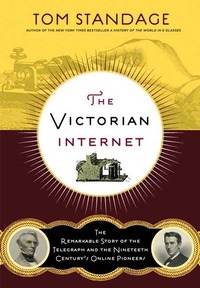Take a photo of a barcode or cover
108 reviews for:
The Victorian Internet: The Remarkable Story of the Telegraph and the Nineteenth Century's On-Line Pioneers
Tom Standage
108 reviews for:
The Victorian Internet: The Remarkable Story of the Telegraph and the Nineteenth Century's On-Line Pioneers
Tom Standage
A very interesting read. Part history, part cultural study, this history of the telegraph is full of amusing anecdotes about how the telegraph changed the world and stories about the eccentrics who developed it.
I really enjoyed learning about the telegraph, and the idea that instant communication isn't exactly new. Well done, Standage.
It's a quick read, I flew through it.
It's a quick read, I flew through it.
informative
lighthearted
fast-paced
An OK general history primer of the telegraph edge and the early industrial area of electricity.
Its far too brief and shallow for my liking, but i enjoyed reading it throughout. All the topics listed on the cover of the book are basically only mentioned in passing. Basically everything is mentioned in passing. I was particularly looking forward to hearing about proto-internet culturevis a vie telegraph operators, but very little is actuallly written about that in this book.
More in fact is written in the epilogue making comparison to the internet, than what came up earlier. Obviously an exercise in adwords.
While a good deal is written about the early pursuits of the telegraph (i particularly enjoyed the part about the optical telegraph), and pneumatic tubes, i feel its criminal to cover very little about Western Union or the relationship with of telegraphs and railroads.
I would recommend reading this as an introduction to deeper topics that can be read about on wikipedia.
Its far too brief and shallow for my liking, but i enjoyed reading it throughout. All the topics listed on the cover of the book are basically only mentioned in passing. Basically everything is mentioned in passing. I was particularly looking forward to hearing about proto-internet culturevis a vie telegraph operators, but very little is actuallly written about that in this book.
More in fact is written in the epilogue making comparison to the internet, than what came up earlier. Obviously an exercise in adwords.
While a good deal is written about the early pursuits of the telegraph (i particularly enjoyed the part about the optical telegraph), and pneumatic tubes, i feel its criminal to cover very little about Western Union or the relationship with of telegraphs and railroads.
I would recommend reading this as an introduction to deeper topics that can be read about on wikipedia.
This is a 10-star book in a five-star world. I loved it. Even if you’re only casually interested in communications history, this book will appeal to you. It is essentially the story of the birth of telegraphy not only in the United States but worldwide. I was fascinated by the brief sketches the author includes here. When we think of telegraphy, we think immediately of Samuel F. B. Morse. But in its earliest iterations, telegraphy was highly visual. Throughout much of Europe, governments constructed towers and used mirrors to create visual telegraphy that would alert additional towers several miles away as to the message. These towers were based on line-of-sight communication, and so they had to be relatively close together. You might, if you have a detailed map of Great Britain, still find places labeled Telegraph Hill or Signal Hill. These labels date back to the times when visual telegraphy was prominent.
As it turns out, Morse was by no means the only person interested in electric telegraphy. Inventors from the United Kingdom and other European countries investigated the idea rather seriously. Other inventors even developed their own codes for use with telegraphy. But it is Morse and his famous code that we remember best. That is the one that became primarily used everywhere. Calligraphy took off in the United States with a greater degree of popularity than in any other country in the world. Open this book and read about the businessman Cyrus Fields, who made multiple attempts at a trans-Atlantic cable before he succeeded. There are probably whole books written about that portion of our history, but I enjoyed the concise brevity with which the author approaches the subject.
There are wonderfully humorous examples of the misinformation surrounding telegraphy. One woman, intent on wiring money to her son, changed the amount because she feared the telegrapher would misplace the loose change in the message. One man became irate in a Telegraph office when the message he crafted remained on the telegrapher’s desk. He refused to believe that the telegrapher sent the message, since the physical piece of paper sat on the desk. Another misinformed woman wanted to redo the form she filled out insisting that her writing was sloppy, and no one could read it easily at the other end.
Just as our modern Internet draws to it hucksters, fraudsters, and cheats, so it was in the world of telegraphy. Gamblers used telegraphy to defraud bookies when the gambler would bet on a specific horse race. Before the bookie could find out who won, a gambler using a telegraphy device would already have that information and could rush a bet on the winning horse.
But this kind of thing went both ways. Cops were the beneficiaries of telegraphy, too. They would often get advanced notice of a Train Robbery and be in position to arrest the robber at the end of the train’s journey.
If you think love online is a relatively recent phenomenon, think again. As telegraphy grew in use, companies employed more women to send the code. Inevitably, conversations of love would spring up under all kinds of circumstances. Often, these love-on-the-wire romances would flourish into marriages. There are numerous accounts here of marriages performed by Telegraph. One such experience happened to a soldier who could not get home on leave. Undaunted, the bride went to a San Diego Telegraph station with her minister, and the telegrapher tapped out the marriage in Morse Code. Since contracts were binding even if sent via Telegraph, the court held that the marriage was equally legitimate. That telegrapher asked other operators to clear the lines that night after business hours between San Diego and the fort where the soldier resided. The telegrapher, bride, and groom encouraged the other operators to stay tuned and consider themselves guests at the wedding. That’s what happened.
You get a look at how telegraphy changed the news business, and what dramatic changes those were! James Gordon Bennett insisted the telegraph would drive newspapers out of business. Most papers initially feared rather than embraced the technology. Ultimately, it was the telegraph that spawned the Associated Press in the U.S. and Reuters in Europe.
Inevitably, the final chapter looks at the invention of the telephone and how it almost instantaneously replaced the Telegraph. The author also uses that chapter to draw fascinating parallels between telegraphy of the 1800s and today’s Internet. This is a short but excellent book no matter what your perspective of communications history is. I thoroughly enjoyed it. I suspect you will as well if you read it.
As it turns out, Morse was by no means the only person interested in electric telegraphy. Inventors from the United Kingdom and other European countries investigated the idea rather seriously. Other inventors even developed their own codes for use with telegraphy. But it is Morse and his famous code that we remember best. That is the one that became primarily used everywhere. Calligraphy took off in the United States with a greater degree of popularity than in any other country in the world. Open this book and read about the businessman Cyrus Fields, who made multiple attempts at a trans-Atlantic cable before he succeeded. There are probably whole books written about that portion of our history, but I enjoyed the concise brevity with which the author approaches the subject.
There are wonderfully humorous examples of the misinformation surrounding telegraphy. One woman, intent on wiring money to her son, changed the amount because she feared the telegrapher would misplace the loose change in the message. One man became irate in a Telegraph office when the message he crafted remained on the telegrapher’s desk. He refused to believe that the telegrapher sent the message, since the physical piece of paper sat on the desk. Another misinformed woman wanted to redo the form she filled out insisting that her writing was sloppy, and no one could read it easily at the other end.
Just as our modern Internet draws to it hucksters, fraudsters, and cheats, so it was in the world of telegraphy. Gamblers used telegraphy to defraud bookies when the gambler would bet on a specific horse race. Before the bookie could find out who won, a gambler using a telegraphy device would already have that information and could rush a bet on the winning horse.
But this kind of thing went both ways. Cops were the beneficiaries of telegraphy, too. They would often get advanced notice of a Train Robbery and be in position to arrest the robber at the end of the train’s journey.
If you think love online is a relatively recent phenomenon, think again. As telegraphy grew in use, companies employed more women to send the code. Inevitably, conversations of love would spring up under all kinds of circumstances. Often, these love-on-the-wire romances would flourish into marriages. There are numerous accounts here of marriages performed by Telegraph. One such experience happened to a soldier who could not get home on leave. Undaunted, the bride went to a San Diego Telegraph station with her minister, and the telegrapher tapped out the marriage in Morse Code. Since contracts were binding even if sent via Telegraph, the court held that the marriage was equally legitimate. That telegrapher asked other operators to clear the lines that night after business hours between San Diego and the fort where the soldier resided. The telegrapher, bride, and groom encouraged the other operators to stay tuned and consider themselves guests at the wedding. That’s what happened.
You get a look at how telegraphy changed the news business, and what dramatic changes those were! James Gordon Bennett insisted the telegraph would drive newspapers out of business. Most papers initially feared rather than embraced the technology. Ultimately, it was the telegraph that spawned the Associated Press in the U.S. and Reuters in Europe.
Inevitably, the final chapter looks at the invention of the telephone and how it almost instantaneously replaced the Telegraph. The author also uses that chapter to draw fascinating parallels between telegraphy of the 1800s and today’s Internet. This is a short but excellent book no matter what your perspective of communications history is. I thoroughly enjoyed it. I suspect you will as well if you read it.
You know you want to read all about how the telegraph ushered in the information age, "wired love" and all! It's fun to follow the trail of inventive genius and the resulting cultural shockwaves. The things humans can do! Loved that every time I had difficulty picturing the mechanisms of one contraption or another, I turned the page only to find a helpful historical diagram!
The comparisons with our modern internet are still apt 10 years on. Maybe more so, from our vantage point of web 2.0 or whatever they're calling it these days. (Though, for my money? The best legacy of the golden age of the telegraph might just be the pile of bad poetry.)
Once you've read this I recommend checking out this book review for a critique and more cool thoughts about elitism, the transformative power of technology, and narratives of progress.
The comparisons with our modern internet are still apt 10 years on. Maybe more so, from our vantage point of web 2.0 or whatever they're calling it these days. (Though, for my money? The best legacy of the golden age of the telegraph might just be the pile of bad poetry.)
Once you've read this I recommend checking out this book review for a critique and more cool thoughts about elitism, the transformative power of technology, and narratives of progress.
My first non-fiction book in quite some time, **The Victorian Internet** is a nice introduction into the rise and fall of the electrical telegraph, and all its implications. *Tom Standage* shows us in an easy, meandering style how the world changed due to the telegraph, and how people changed (and/or didn't). While he's often very direct (or on the nose) about his theories, and some minor facts looked not quite well researched (Karlsruhe was never part of Prussia, thank you very much), I liked both the very human approach to history, and his final – if simplistic – comparison between telegraph an internet evolution.
A fun read! I found the first half or so faster reading than the second half (ending each chapter with nice challenges to overcome drives me forward), but I really enjoyed learning about something I barely even think about when it's mentioned in old stories or other nonfiction books. I was kind of amazed at how much they were able to do with it and how it led to the telephone. Learning about some of the culture around telegraph operators and weird anecdotal stories was also great.
It was also interesting reading the last few pages considering the release of this book in the late 90s and the baby internet.
It was also interesting reading the last few pages considering the release of this book in the late 90s and the baby internet.
funny
informative
medium-paced
Fantastic.
Almost as much fun as Pratchett's Going Postal - Going Post being a large part of why I ended up reading this book. Although predictably, the real story of the telegraph wasn't as simple as "small group of genius engineers invent the telegraph which is then taken over and run into the ground by a band of pirates". It's more like: in France a system of semaphore-like "optical telegraphs" were constructed, which were then refined in Britain into telegraphs which conveyed 4-bit messages. In Britain, an inventor (Cooke) and arrogant, conceited scientist (Wheatstone) developed this into the electric telegraph, while simultaneously in America, Morse, along with Gale (academic) and Vale (machinist and inventor) invented a superior system. The telegraphy system was taken up by big businesses in America (notably Western Union) and governments in Europe. The lion's share of the profits from telegraphy were taken up by the big businesses, but after some kerfuffle the original inventors were generally pretty well remunerated.
The impression I got from this is that the original telegraph system in France was a spark that ignited an unstoppable progression of global interconnectedness which continuously led to the internet. As soon as optical telegraphs came into existence, a ton of inventors and entrepreneurs immediately saw the potential of electric telegraphs, and although each of them encountered friction in getting their version of the telegraph off the ground, the group of them were sooner or later bound to build up enough momentum for the whole system to be picked up by industry-at-large, and from there the beast became unstoppable.
Some fun facts:
* Bell invented the telephone as an off-shoot of trying to send more telegraph channels over a single wire. At first, everyone thought it was an insignificant variant of the telegraph. "Spoken telegraph".
* For particularly high-traffic edges in the telegraph network, it was often easier to simply send messages via underground pneumatic tubes. In fact, at one point France set up a whole national network of nothing but pneumatic tubes!
* It is said that whenever a new technology or medium emerges, one of the first uses it will be put to is pornography. There was no mention of pornography in relation to the telegraph, but there was lots of interesting stuff about romance. Several romances blossomed between telegraph operators (because telegraph operating was delicate mechanical work (like knitting) it was deemed appropriate for ladies). A couple of marriages were even conducted over the telegraph.
* A whole industry of code making and breaking grew up with the telegraph. So much so that there were different rates for sending cipher text and plaintext (the former being more taxing for operators to send). The main users of codes were: spies, lovers, and bankers.
* While we're on the subject, apparently people used to send each other cipher text through newspapers, as newspapers are less conspicuous than letters. Charles Babbage made a hobby of decrypting other people's messages and on at least one occasion interrupted an encrypted conversation between a pair of lovers.
* Surprisingly, newspapers hated the telegraph and thought that instant access to global information meant they'd be out of the job, rather than them actually having a raison d'etre now.
Almost as much fun as Pratchett's Going Postal - Going Post being a large part of why I ended up reading this book. Although predictably, the real story of the telegraph wasn't as simple as "small group of genius engineers invent the telegraph which is then taken over and run into the ground by a band of pirates". It's more like: in France a system of semaphore-like "optical telegraphs" were constructed, which were then refined in Britain into telegraphs which conveyed 4-bit messages. In Britain, an inventor (Cooke) and arrogant, conceited scientist (Wheatstone) developed this into the electric telegraph, while simultaneously in America, Morse, along with Gale (academic) and Vale (machinist and inventor) invented a superior system. The telegraphy system was taken up by big businesses in America (notably Western Union) and governments in Europe. The lion's share of the profits from telegraphy were taken up by the big businesses, but after some kerfuffle the original inventors were generally pretty well remunerated.
The impression I got from this is that the original telegraph system in France was a spark that ignited an unstoppable progression of global interconnectedness which continuously led to the internet. As soon as optical telegraphs came into existence, a ton of inventors and entrepreneurs immediately saw the potential of electric telegraphs, and although each of them encountered friction in getting their version of the telegraph off the ground, the group of them were sooner or later bound to build up enough momentum for the whole system to be picked up by industry-at-large, and from there the beast became unstoppable.
Some fun facts:
* Bell invented the telephone as an off-shoot of trying to send more telegraph channels over a single wire. At first, everyone thought it was an insignificant variant of the telegraph. "Spoken telegraph".
* For particularly high-traffic edges in the telegraph network, it was often easier to simply send messages via underground pneumatic tubes. In fact, at one point France set up a whole national network of nothing but pneumatic tubes!
* It is said that whenever a new technology or medium emerges, one of the first uses it will be put to is pornography. There was no mention of pornography in relation to the telegraph, but there was lots of interesting stuff about romance. Several romances blossomed between telegraph operators (because telegraph operating was delicate mechanical work (like knitting) it was deemed appropriate for ladies). A couple of marriages were even conducted over the telegraph.
* A whole industry of code making and breaking grew up with the telegraph. So much so that there were different rates for sending cipher text and plaintext (the former being more taxing for operators to send). The main users of codes were: spies, lovers, and bankers.
* While we're on the subject, apparently people used to send each other cipher text through newspapers, as newspapers are less conspicuous than letters. Charles Babbage made a hobby of decrypting other people's messages and on at least one occasion interrupted an encrypted conversation between a pair of lovers.
* Surprisingly, newspapers hated the telegraph and thought that instant access to global information meant they'd be out of the job, rather than them actually having a raison d'etre now.






